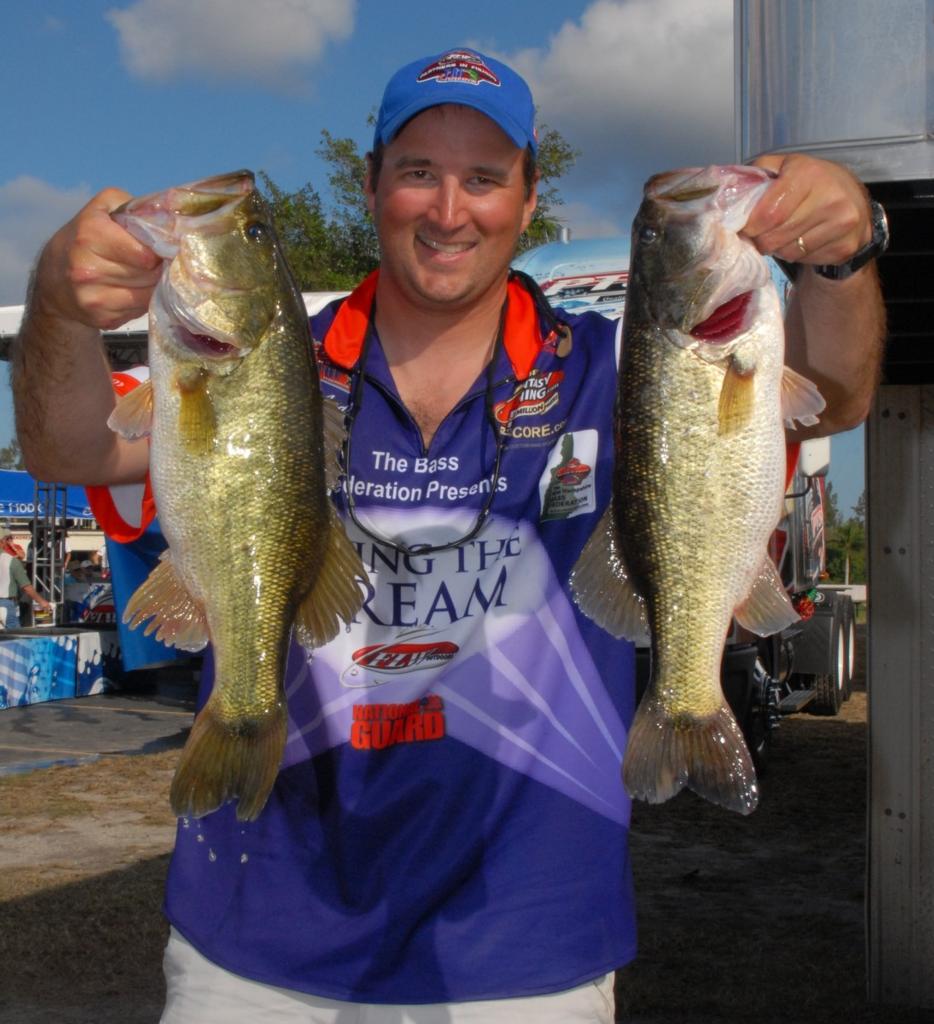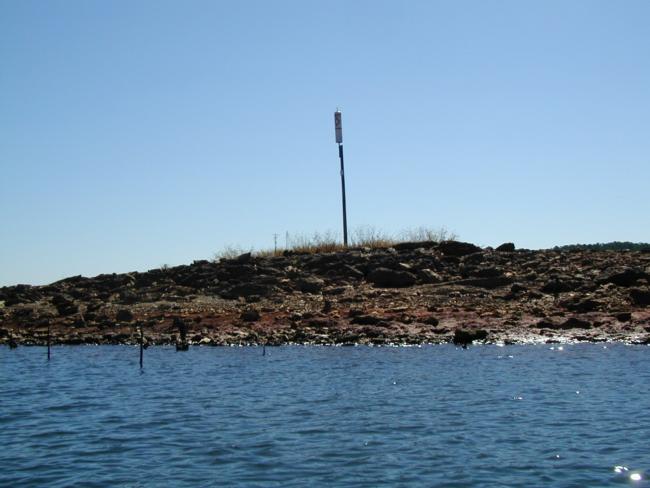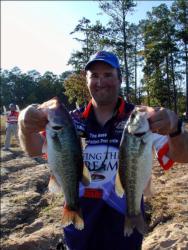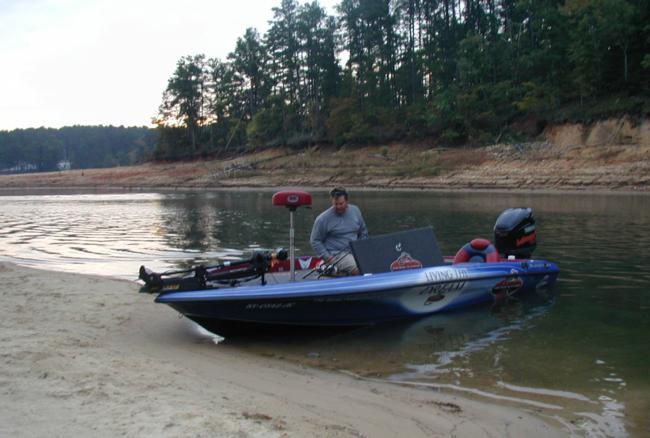Living the Dream: Clarks Hill, Part 3
Dave Andrews details first day of competition in FLW Series event on Clarks Hill Lake

————————————-
Editor’s note: This is the third piece in a series of journal entries from Dave Andrews, winner of the 2007 TBF National Championship, detailing his fourth stop on the 2008 FLW Series Eastern schedule. Clarks Hill Lake marked the final event of his “Living the Dream” season. Entries were published at FLWOutdoors.com throughout the course of the season. As winner of the Living the Dream package, offered by FLW Outdoors through The Bass Federation, Andrews had his entry fees paid to test his club skills on the pro tour with the use of a fully wrapped boat and tow package. Andrews will chronicle his adventure in pro bass fishing, having most recently competed on Georgia’s Clarks Hill Lake. Segments of his journal will be posted approximately weekly. (Read Part 1 and Part 2)(Read his Lake Champlain journal; this links to the final entry, which provides links at the top for each preceding part)
————————————-
Walmart FLW Series BP Eastern Division
Stop No. 4: Clarks Hill Lake
Oct. 22-25, 2008
Competition: Day one
Oct. 22
The predawn hours of Wednesday featured slightly milder conditions then the previous three or four days. Scott and I were up at 4:30 a.m. and on the road by 5:20. It took about 40 minutes to drive from our hotel in Augusta to the launch at Spring Creek. We wanted to get in the water before the sun came up to ensure that we would get a parking space and have plenty of time to drive the Ranger over to Wildwood Park in case of fog. I had mapped out the six-mile drive the day before, so I could just follow my GPS track through the maze of shoals and islands in the dark.
Because of the milder night, there was no fog, and this made it easier for everyone to get launched and boat over to the takeoff location. With the low water, there was plenty of room to beach the boat and find partners. I dropped off Scott, wished him luck and quickly found my partner, Jacques. We still had  plenty of time to wait before the 8 a.m. takeoff.
plenty of time to wait before the 8 a.m. takeoff.
The morning was bright and sunny with light winds – a continuation of the stable weather pattern of the last few practice days. Perfect conditions, I thought, to blade up some morning largemouths. When our number was finally called, I drove the Z520 out of Keg Creek and soon pulled up on the point where I had caught the biggest fish on the final practice day. There were several boats fishing around the shoals and islands nearby, but only one or two that were working my best section of points and pockets.
I fished fast, burning the ¾-ounce Buckeye Spinnerbait just under the surface. I chose the larger spinnerbait because of the early-morning, low-light conditions. I wanted a bait that threw a big wake across the lakes surface. It took a lot of concentration to keep the bait bulging the water without cranking too fast so that bait broke the surface and skittered unnaturally. I had noticed in practice that when frightened, the small shad and shore minnows would bulge the water along the weed edges, and I really felt that by waking the big spinnerbait, I was triggering bass to explode on the lure, thinking it was a fleeing baitfish. Soon after starting, I had a nice fish boil on the spinnerbait, but not get the hook. A few casts later, I got another solid strike and soon had my first keeper in the tournament, a decent 14-inch largemouth bass.
I moved into the next little bay and worked down a section of rather nondescript bank that featured a nice grass edge with clearly defined holes in the backs of the little rounded pockets. I’d caught a couple nice keepers here in practice and was hoping for a repeat performance today. The sun was getting high in a cloudless sky, and the slight morning breeze had dropped to just about nothing. I switched to the 1/2-ounce shad-colored spinnerbait and continued to burn it across the surface. A shallow cast along a hole in the weeds produced a swirl and a jarring strike. The bass got the hook, and the battle was on. A few moments later, my partner netted a solid 2-pounder.
I continued along this shoreline, crossing over to fish the other side of the small bay. There were a couple of rather boring-looking points and pockets that didn’t have much grass, but something told me to give them a shot. Since these pockets didn’t feature any grass or really any shallow cover, I concentrated on the long sloping points that tapered into 8 to 10 feet of water and then quickly plunged into the river channel. On one of the points, I was watching my spinnerbait come across the surface when a big largemouth appeared out of nowhere and grabbed the offering. I called for the net, but it took a while to play the fish out. She jumped once and then just bulldogged toward the bottom. After a  few nervous moments, I had the bass safely in the net. It was a nice 3-pound largemouth and was my third keeper of the day.
few nervous moments, I had the bass safely in the net. It was a nice 3-pound largemouth and was my third keeper of the day.
I worked the spinnerbait for another hour without a bite. I had wanted to commit to the spinnerbait for the entire day, but the fish were clearly telling me that they no longer wanted it. At 11 a.m., I put it down for the day. I was digging in my rod locker for my spinning rod when my partner called for the net. His first fish was also a good one, nearly 3 pounds, and was caught on a small worm on a drop-shot rig. This further confirmed the need to slow down and finesse the fish. I switched gears easily, mentally committing the rest of the day to fishing slow with spinning gear, a ¼-ounce Gambler Giggy Head with a 4-inch Zoom Finesse Worm in watermelon-candy color. I used 20-pound Daiwa Samurai braid tied to a short 6-pound Gamma fluorocarbon leader.
I worked my way along the bank toward one of two little points that featured nice walls of hydrilla that fell quickly into 12 to 14 feet of water on the outside edge. I cast parallel to the outside of the weed edge and slowly dragged the worm back to the boat. Whenever I felt the weeds grabbing the bait, I’d pop the rod and the line would cut the weeds and allow me to complete the cast without having to reel in and clear the bait. About 15 minutes after switching over, I got a tap and set the hook. The fish was small, so I just flipped it into the boat, but the 13-incher was my fourth keeper and was an important fish, as it kept my confidence high that I had made the right decision to switch techniques.
I fished over to the second little point and cast out into 15 feet of water on the deep edge of the point. I had a bite and set the hook, and a nice bass cartwheeled out of the water. Even though I had braided line, I worried about the light leader, so I took my time, and eventually my partner slid the net under my limit fish, a solid bass in the 2 1/2-pound range.
It was just after noon, and I had a decent limit and plenty of time to cull up. I put a new worm on, cast out again into the deep water and immediately felt a tap on the worm. I set the hook and the rod bent over, but a few seconds later, the fish just came off. I shook it off and kept fishing. The lost fish hurt a lot less with the limit already in the livewell.
At 1 p.m., I was back on one of the little grassy points when I felt a bass pick up my worm out in deep water. I set the hook and fought a nice bass to the boat. This fish was close to 2 1/2 pounds and would cull my smallest bass. I picked up a solid 1 1/2 pounds on the exchange and now had a really nice limit. I worked back over to where my partner had caught his lone keeper. The spot featured a wooden fence with some rock on the bottom in roughly 25 feet of water. We both cast to the fence and both got bit right away. My fish was a small keeper, which wouldn’t help me, so I just flipped it into the boat. My partner’s fish was much bigger, so I grabbed the net, and soon he had boated his second keeper, a solid 2 1/2-pound largemouth, again on the drop-shot rig.
We bounced around, back over to the original start spot, then to some grass lines farther into the creek, but didn’t have any further success until late in the afternoon. With little time remaining before check-in, I drove back, close to the Wildwood Park, and stopped on a little edge that featured gravel and chunk rock. I had noticed it the final practice day, but couldn’t fish it because another boat was on it. It was only about 30 yards long, but was different than any other shoreline in the area. Most of the rest of the creek featured red clay banks. We pulled up with about 20 minutes to fish and I immediately caught a 14-inch keeper that I couldn’t use. Jacques threw his trusty drop-shot and 4-inch Roboworm and soon had his third keeper in the boat. I boated another fish, then with time running out, Jacques landed his fourth and fifth keepers. They were small, but would mean a lot to him on the co-angler side, where limits would be scarce.
We checked in and were told to immediately bag our fish. Being in one of the later flights, this was rare. It meant that there were few fish coming across the scales, and I took it as a good sign for us. Indeed, the weigh-in line was short, and we were on the stage in no time. My five-fish limit weighed 9 pounds, 15 ounces and put me in 23rd place at the time. My co-angler’s limit weighed 7-15, and he would finish  the day in second place in his division. I parted company with Jacques and wished him luck the rest of the way. I found my travel mate, Scott, and we transferred his equipment to my boat and headed back to Spring Creek to pull out and make the long drive back to Augusta.
the day in second place in his division. I parted company with Jacques and wished him luck the rest of the way. I found my travel mate, Scott, and we transferred his equipment to my boat and headed back to Spring Creek to pull out and make the long drive back to Augusta.
That night we went online to find that I had landed in 30th place for the day and was less than 2 pounds out of the top-10 cut. During one of the practice days, I was discussing the layout of Clarks Hill with Scott, and we talked about how well the lake set up for a deep crankbait bite. Deep cranking is not a strength of mine, so we never tried it in practice; the place is just too huge to attempt to break down such a needle-in-a-haystack pattern, but we both figured that crankbait king and veteran FLW angler David Fritts would have a good tournament. All of the talk at the day-one weigh-in was focused on Fritts and his monstrous 23-9 catch. He led by over 8 pounds and had clearly found the mother lode with his crankbaits. It was early in the tournament, but it was apparent that we were all fishing for second place.
I didn’t come down here with very high expectations, but another 8- to 10-pound limit on day two would have me in contention for the top 10. I was excited, but nervous about the impending weather change. We grabbed takeout and worked on tackle until 10 p.m.
————————————-
Editor’s note: Stay tuned for Part 4, in which Andrews will write about the second day of competition at the FLW Series tourney on Clarks Hill Lake.
————————————-